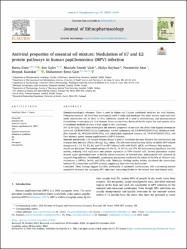Antiviral properties of essential oil mixture: Modulation of E7 and E2 protein pathways in human papillomavirus (HPV) infection

View/
Date
2024Author
Üner, BurcuGüler, Ece
Vicir, Mustafa Emrah
Kayhan, Hülya
Atsü, Necmettin
Kalaskar, Deepak
Çam, Muhammet Emin
Metadata
Show full item recordCitation
Üner B., Güler E., Vicir M. E., Kayhan H., Atsü N., Kalaskar D., Çam M. E. Antiviral properties of essential oil mixture: Modulation of E7 and E2 protein pathways in human papillomavirus (HPV) infection (2024). Journal of Ethnopharmacology, c.341.Abstract
Ethnopharmacological relevance: Clove is used in Indian and Chinese traditional medicine for viral diseases.
Palmarosa essential oils have been traditionally used in India and Southeast Asia since ancient times and have
made considerable use of them. In New Caledonia, niaouli oil is used in aromatherapy and pharmaceutical
formulations to treat pain and viral diseases. Since ancient times, the South Pacific region has used tamanu oil as
a traditional medicine to treat a wide range of skin conditions.
Aim of the study: This study investigates the antiviral properties of essential oils (EOs) from Eugenia aromaticum
(clove oil, CL-R030424005 (CL)), Cymbopogon martinii (palmarosa oil, PA-R040923008 (PA)), Melaleuca viridi flora (niaouli oil, NI-R290124038 (NI)), and Calophyllum inophyllum (tamanu oil, TA-F140224029 (TA)), and
their mixture against human papillomavirus (HPV) infection.
Materials and methods: A D-optimal mixture design is used to determine the most effective EO combinations and
evaluate their antiviral efficacy through IC50 values. The EOs were tested for their ability to inhibit HPV-related
oncogenes (L1, L2, E1, E2, E6, and E7) in HPV-infected cells with ELISA, qPCR, and Western blot analyses.
Results and discussion: The optimal mixture (31.5% CL, 31.5% PA, and 37% NI) demonstrated significant antiviral
activity, reducing viral replication and protein expression in HPV-infected cells. Ex-vivo permeation studies
showed higher permeation rates in healthy tissues compared to infected ones, indicating the oils’ potential in
targeted drug delivery. Additionally, cytotoxicity assessments confirmed the safety of the EOs at effective con centrations in HPVCs, DoTc2, and HEKa cells. Molecular docking studies further elucidated the interactions
between EO components and HPV proteins, supporting their antiviral mechanisms.
Conclusion: These findings suggest that EOs, particularly in optimized combinations, offer a promising natural
supportive treatment for managing HPV infections, warranting further in vivo animal tests and clinical trials.
Source
Journal of EthnopharmacologyVolume
341URI
https://doi.org/10.1016/j.jep.2024.119289https://www.sciencedirect.com/science/article/pii/S0378874124015885?via%3Dihub
https://hdl.handle.net/20.500.12780/996

















